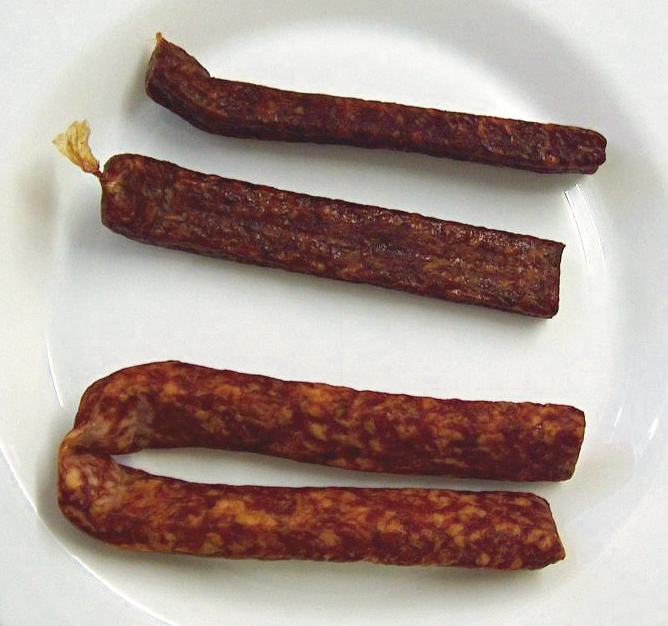Landjäger on:
[Wikipedia]
[Google]
[Amazon]
 Landjäger is a semidried sausage traditionally made in
Landjäger is a semidried sausage traditionally made in
 Landjäger is a semidried sausage traditionally made in
Landjäger is a semidried sausage traditionally made in Southern Germany
Southern Germany () is a region of Germany which has no exact boundary, but is generally taken to include the areas in which Upper German dialects are spoken, historically the stem duchies of Bavaria and Swabia or, in a modern context, Bavaria ...
, Austria
Austria, , bar, Östareich officially the Republic of Austria, is a country in the southern part of Central Europe, lying in the Eastern Alps. It is a federation of nine states, one of which is the capital, Vienna, the most populous ...
, Switzerland, and Alsace
Alsace (, ; ; Low Alemannic German/ gsw-FR, Elsàss ; german: Elsass ; la, Alsatia) is a cultural region and a territorial collectivity in eastern France, on the west bank of the upper Rhine next to Germany and Switzerland. In 2020, it had ...
. It is popular as a snack food during activities such as hiking
Hiking is a long, vigorous walk, usually on trails or footpaths in the countryside. Walking for pleasure developed in Europe during the eighteenth century.AMATO, JOSEPH A. "Mind over Foot: Romantic Walking and Rambling." In ''On Foot: A Histor ...
. It also has a history as soldier's food because it keeps without refrigeration
The term refrigeration refers to the process of removing heat from an enclosed space or substance for the purpose of lowering the temperature.International Dictionary of Refrigeration, http://dictionary.iifiir.org/search.phpASHRAE Terminology, ht ...
and comes in single-meal portions. As a meal, landjäger sausage can be boiled and served with potatoes and fresh greens.
Name
According to the '' Swiss German Dictionary'', the name ''Landjäger'' was possibly derived from the dialect expression ''lang tige(n)'' 'smoked for a long time, air-cured for a long time.' The humorous reinterpretation in the sense of 'mounted police' may be inspired by comparing the stiffness of sausages with the perceived military rigidity of a police officer. The Alsatian and French names for smoked air-cured sausage, ''Gendarm'' and ''gendarme'', are apparently translations of the folk-etymologized German name. "Jäger" should be remembered as a direct, simplified translation from German, meaning "hunter." This could explain the sausage's renewed popularity in the more northern and German-settled parts of the United States. Dedicated hunters consider landjägers as food for hunters taking game to carry on the traditions associated with a lifestyle from previous generations of hunters. A very similar semi-dried sausage known as '' salamino cacciatore'' (translation: "hunter's sausage") is traditionally produced in Central and Northern Italy.Ingredients
Landjäger sausages are made of roughly equal portions ofbeef
Beef is the culinary name for meat from cattle (''Bos taurus'').
In prehistoric times, humankind hunted aurochs and later domesticated them. Since that time, numerous breeds of cattle have been bred specifically for the quality or quantit ...
and pork
Pork is the culinary name for the meat of the domestic pig (''Sus domesticus''). It is the most commonly consumed meat worldwide, with evidence of pig husbandry dating back to 5000 BCE.
Pork is eaten both freshly cooked and preserved; ...
with lard, sugar, red wine, and spices. They are each in length, made into links of two. Before smoking and drying, they are pressed into a mold, which gives them their characteristic rectangular cross-section of about . Typically, a pair of Landjäger weighs about 100 g and contains about 516 kcal
The calorie is a unit of energy. For historical reasons, two main definitions of "calorie" are in wide use. The large calorie, food calorie, or kilogram calorie was originally defined as the amount of heat needed to raise the temperature of o ...
. In Austria, Landjäger is sometimes made using horse meat
Horse meat forms a significant part of the culinary traditions of many countries, particularly in Eurasia. The eight countries that consume the most horse meat consume about 4.3 million horses a year. For the majority of humanity's early existen ...
.
See also
*Culinary Heritage of Switzerland
The Culinary Heritage of Switzerland (german: Kulinarisches Erbe der Schweiz, french: Patrimoine culinaire suisse, it, Patrimonio culinario svizzero, rm, Patrimoni culinar svizzer) is a multilingual online encyclopedia of traditional Swiss cuis ...
* List of sausages
* '' Salamino cacciatore''
References
External links
* Alsatian cuisine German sausages Swiss sausages Culinary Heritage of Switzerland Fermented sausages {{germany-sausage-stub